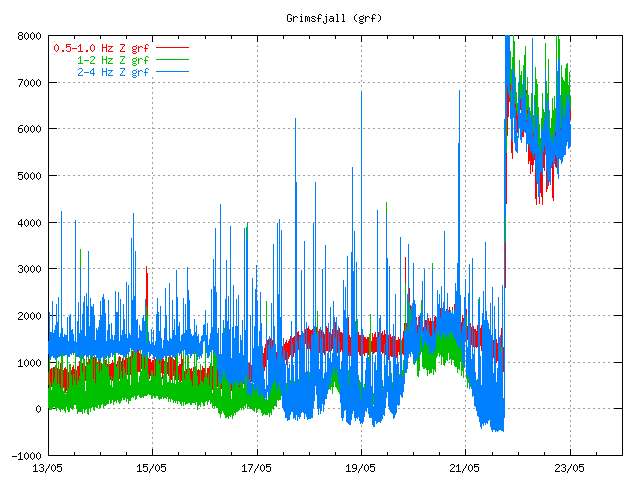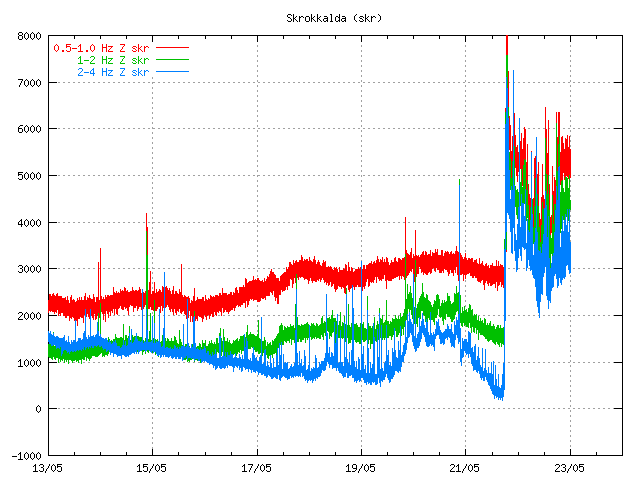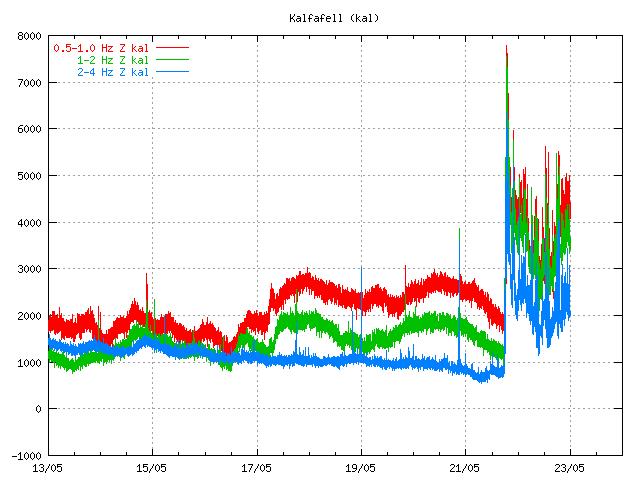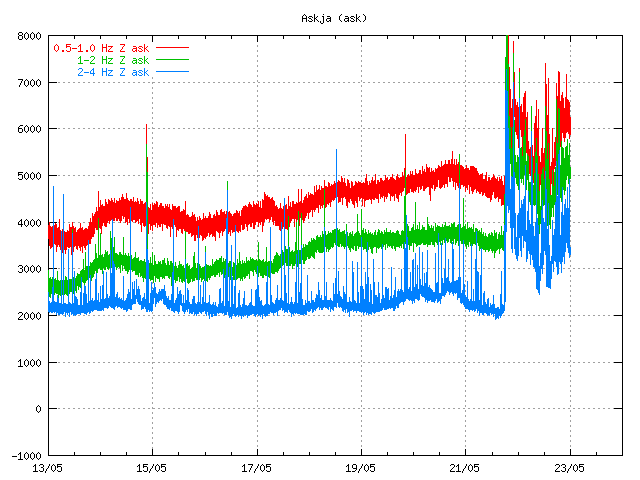Here are few harmonic tremor charts from the Grímsfjall volcano / Grímsvatn eruption. It can clearly be seen where the eruption looses strength for an few hours. It is also clear when the eruption starts to regain it’s eruption strength again.
The volcanic tremor is best seen on 0.5 – 1Hz band, alongside 1 – 5Hz bands.

Grímsfjall volcano / Grímsvötn SIL station.
All pictures are from Icelandic Met Office web page. Copyright of this pictures belongs to them.






Jon
Oh I see- they’ve got smaples – ash composition
Peter
Strong storm in SE Iceland right now: http://www.icelandreview.com/icelandreview/daily_news/Not_Just_Eruption_Crazy_Storm_in_Southeast_Iceland_0_378149.news.aspx
http://en.vedur.is/media/jar/Grimsvotn_status_2011-05-23_IES_IMO.pdf
Re. ash samples: today’s IMO report has the first analysis:
http://en.vedur.is/media/jar/Grimsvotn_status_2011-05-23_IES_IMO.pdf
“The grains are glassy with micro crystals of plagioclase. Samples well sorted.
Whole rock analysis: Basalt, with 50-51 Wt% SiO2
Leachate results: 5-10 mg/kg of waterdissolvable flour
Grain size distribution: about 10% of the volume of the analyzed samples is finer than 10 micrometers”
Mike
Been lurking here for months reading all your comments. That sequesnce of pictures is amazing. Thank you so much for all the information. I find it all fascinating!
This afternoon I cannot see the plume anymore due to weather conditions. No more ash has fallen in Selfoss which is good. Last time it was visible was today at lunch time. The weather has been overcast, misty and winds strong (from the north which blow the ash into UK). Webcams in Jokullsarlon and Grimsvotn only show clouds and fog. There is actually a storm coming from eastern Iceland.
In radar, there seems to be something there but if its the plume and not rain, its small. Also the tremor has decreased. The eruption seems to be winding down or passing to a more efusive stage.
Tomorrow, the weather might clear up a bit, and afford better views. Scotland should see flight disruption tomorrow, and the UK by Thursday and Friday. If the eruption decreases, there is a change of no disruption. Also this ash will be travelling less high because is bigger sized – it falls down faster – so it presents less risk to airplanes.
After I wrote my comment, I read on the BBC that flights have already been cancelled for tomorrow in Scotland. Likely the same will happen for Ireland.
England will not be affected tomorrow, but might be by Wednesday night.
I think projecting weather models in the long-run for the UK: the wind will first be from west, then more southwest as a new front approaches (which might save England from disruption by Thursday). This might mean that disruption in London might only happen for a single day, around Wednesday, at least until the weekend.
Remember last year’s eruption? That too was picked on stations far from Eyjafjallajökull, especially the first blast. Since this eruption is, and I quote, “ten times as large”, doesn’t it stand to reason that the tremor must be picked up some 3.1 times further away (square root of ten)? If the tremor from the Eyjafjallajökull eruption was picked up by sensors up to 80 km away, this one must be detectable at some 250 km. Nothing to be alarmed about there at all!
Alas, with the relative scarcity of information, we humans tend to fill in the gaps, i.e. imagine what is not supplied and most likely not there. The only information I have heard about the size of the erupting crater/fissure is that it may be as large as 800 m. Is that a crater with the diameter of 800 m or is it a fissure of 800 m length (similar in length to the Fimvöduhalsi one)? Is there only one “mouth” or are there more? Pity that the Icelandic Coastguard has not flown over and provided radar images as they did with Eyjafjallajökull!
New blog post is up!
http://www.ruv.is/frett/ekkert-akvedid-um-folksflutninga
According to the article, 2000 tons are being ejected every second. That’s approximately 700 cu m per second, 2,500,000 per hour and 60,000,000 per day. A guesstimate based on this would be a total of about 150,000,000 – 200,000,000 cu m (0,15 – 0,20 cu km), a comfortable VEI 4 and more than the entire output of Eyjafjallajökull in a little over 48 hours.